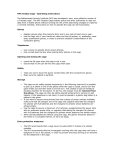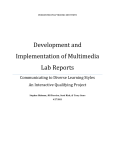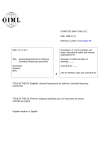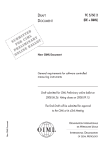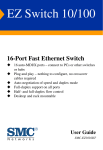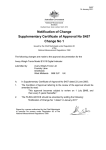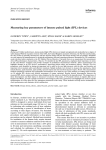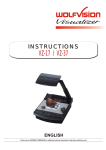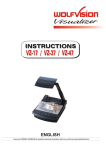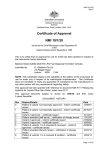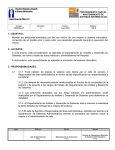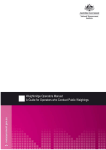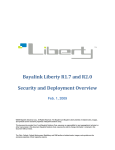Download NMI R 126 Evidential Breath Analysers
Transcript
NMI R 126 Pattern Approval Specifications for Evidential Breath Analysers (OIML R 126:1998(E), NEQ) The English version of international standard OIML R 126:1998 Evidential Breath Analyzers has been adapted to become the non-equivalent national standard with the reference number NMI R 126 © Commonwealth of Australia 2003 — July 2003 (NSC R 126) — July 2004 (renamed NMI R 126) — June 2013 First edition First edition, first revision First edition, second revision National Measurement Institute Bradfield Road, Lindfield, NSW 2070 PO Box 264, Lindfield, NSW 2070 T F W (61 2) 8467 3600 (61 2) 8467 3610 www.measurement.gov.au AMENDMENTS Item no Date Page Location 1 01/06/2013 all all 2 01/06/2013 6 to 8 3 01/06/2013 7 Details of change Made minor editorial changes. Updated reference to tables. Deleted references to verification and reverification to clauses 6.14, ensure consistency with the national measurement 8, 8.2 and 8.3 legislation and Clarified the practical instructions detailing requirements clause 7 for metrological records. ii CONTENTS Amendments .......................................................................................................................................... ii 1. Scope ............................................................................................................................................ 1 2. Applications ................................................................................................................................. 1 3. Terminology ................................................................................................................................. 1 3.1 3.2 3.3 3.4 3.5 3.6 3.7 3.8 3.9 3.10 3.11 3.12 3.13 3.14 3.15 Evidential Breath Analyser (EBA) ........................................................................................ 1 Non-portable Evidential Breath Analyser ............................................................................ 1 Portable Evidential Breath Analyser .................................................................................... 1 Deep Lung Air ...................................................................................................................... 1 Alveolar Air .......................................................................................................................... 1 Extraneous Alcohol .............................................................................................................. 1 Interfering Substance .......................................................................................................... 1 Normal Operation ................................................................................................................ 1 Stand-by Mode .................................................................................................................... 1 Measuring Mode .................................................................................................................. 1 Device for Adjustment to a Standard ................................................................................... 2 Device for Adjustment by Simulation ................................................................................... 2 Adjustment-checking Operation .......................................................................................... 2 Drift ...................................................................................................................................... 2 Memory (Residual) Effect .................................................................................................... 2 4. Physical Quantities and Units of Measurement ....................................................................... 2 5. Metrological Requirements ......................................................................................................... 2 5.1 5.2 5.3 5.4 5.5 5.6 6. Maximum Permissible Errors ............................................................................................... 2 Repeatability ........................................................................................................................ 3 Drift ...................................................................................................................................... 3 Memory and Residual Effect ............................................................................................... 3 Influence Quantities ............................................................................................................. 3 Durability .............................................................................................................................. 4 Technical Requirements ............................................................................................................. 4 6.1 6.2 6.3 6.4 6.5 6.6 6.7 6.8 6.9 6.10 6.11 6.12 6.13 6.14 6.15 Measurement Range ........................................................................................................... 4 Scale Interval ....................................................................................................................... 4 Display ................................................................................................................................. 4 Printing Device ..................................................................................................................... 4 Measuring Conditions .......................................................................................................... 5 Safety and Security ............................................................................................................. 5 Return to Zero...................................................................................................................... 5 Checking of Correct Operation ............................................................................................ 5 Adjustment or Checking of Correct Adjustment .................................................................. 6 Warm-up Time ..................................................................................................................... 6 Measuring Cycle .................................................................................................................. 6 Length of Time During which the Result is Indicated .......................................................... 6 Minimum Volume ................................................................................................................. 6 Markings .............................................................................................................................. 6 Breath Sampling System ..................................................................................................... 7 7. Practical Instructions .................................................................................................................. 7 8. Metrological Controls .................................................................................................................. 7 8.1 8.2 8.3 Pattern Approval .................................................................................................................. 7 Initial Certification ................................................................................................................ 7 Periodic Certification ............................................................................................................ 8 iii 9. Test Method .................................................................................................................................. 8 9.1 9.2 9.3 9.4 9.5 9.6 General ................................................................................................................................ 8 Characteristic Reference Values of the Test Gas ............................................................... 8 Maximum Permissible Errors and Repeatability.................................................................. 9 Drift ...................................................................................................................................... 9 Memory and Residual Effect ............................................................................................... 9 Durability Tests .................................................................................................................... 9 Annex A. Influence of Variations of the Parameters which Characterise the Test Gases (Mandatory) ........................................................................................................................................... 11 A.1 A.2 A.3 A.4 A.5 A.6 Influence of Delivered Volume........................................................................................... 11 Influence of Duration of Exhalation.................................................................................... 11 Influence of Duration of Plateau ........................................................................................ 11 Influence of Mass Concentration of Carbon Dioxide ......................................................... 11 Influence of Interruption in the Flow of Breath ................................................................... 11 Test Simulating the Presence of Alcohol in the Upper Respiratory Tracts ....................... 11 Annex B. Physical Influence Factors (Mandatory) ........................................................................... 12 B.1 B.2 B.3 Test Conditions .................................................................................................................. 12 Reference Conditions and Rated Operating Conditions ................................................... 12 Requirements .................................................................................................................... 12 Annex C. Physiological Influence Factors (Mandatory) ................................................................... 13 Annex D. Physical Disturbances (Mandatory) .................................................................................. 14 D.1 D.2 D.3 D.4 D.5 D.6 D.7 D.8 D.9 D.10 Power Fluctuations ............................................................................................................ 14 Parasitic Voltages and Disturbances on the Mains ........................................................... 14 Vibration ............................................................................................................................. 15 Mechanical Shock.............................................................................................................. 15 Electrostatic Discharge ...................................................................................................... 15 Electromagnetic Field (see also IEC 61000-4-3)............................................................... 16 Magnetic Field ................................................................................................................... 16 Damp Heat Cyclic (for Portable EBAs Only) ..................................................................... 16 Storage Ambient Conditions (for Portable EBAs Only) ..................................................... 16 Shakes (for Portable EBAs Only) ...................................................................................... 16 Annex E. Test Report Format.............................................................................................................. 17 Annex F. Evolution of Concentration with Time (Informative) ........................................................ 23 Annex G. General Example of an Apparatus for Testing Evidential Breath Analysers (Informative) ......................................................................................................................................... 24 G.1 G.2 General .............................................................................................................................. 24 Bubble Train ...................................................................................................................... 24 Annex H. Test Simulating the Presence of Alcohol in the Upper Respiratory Tracts (Informative) ......................................................................................................................................... 27 References ............................................................................................................................................ 28 iv 1. SCOPE 1.1 This document applies to evidential breath analysers (hereafter referred to as EBAs) which are instruments that automatically measure the mass concentration of alcohol in exhaled breath. For the purpose of this document, all references to alcohol are taken to mean ethanol. 1.2 This document does not apply to breath alcohol screening devices which only detect alcohol without providing a sufficiently accurate measurement (see 2.2). 1.3 The performance requirements given here apply to EBAs using currently available technology. This is not intended to restrict technical development or exclude the use of other technologies as a means for analysis. 1.4 Authorities may require EBAs to include a specific conversion device that converts the measurement result obtained in terms of alcohol content in the exhaled breath at the measuring conditions either into physiological conditions or in terms of other quantities. This document does not cover the metrological performance of such devices. 1.5 The purpose of this document is to define the performance requirements of EBAs and the methods employed in testing them. 2. APPLICATIONS 2.1 EBAs can be used to measure accurately, to display numerically and to record the breath alcohol mass concentration of persons (drivers, workers, etc.) who may have consumed alcohol. 3.2 Non-portable Evidential Breath Analyser An EBA intended only for use within buildings or places providing stable environmental conditions. 3.3 Portable Evidential Breath Analyser An EBA that may be used in any location. 3.4 Deep Lung Air Breath originating primarily from the alveoli of the lungs, normally referred to as endexpiratory breath. 3.5 Alveolar Air Air contained in the pulmonary alveoli. 3.6 Extraneous Alcohol Alcohol originating from sources other than the lung. 3.7 Interfering Substance A substance other than ethanol, and present in the provided sample, which potentially interferes with accurate analysis. 3.8 Normal Operation The mode of usage which corresponds to the program of operations specified for EBAs in service. 3.9 Stand-by Mode 2.2 Screening devices are not generally used for establishing proof of driving under the influence of alcohol but are used as detectors of alcohol in the breath. The mode of the EBA in which only certain circuits are pre-energised in order to conserve power and/or prolong component life, and to attain the measuring mode more rapidly than would be possible if starting from the unpowered state. 3. TERMINOLOGY 3.10 3.1 Evidential Breath Analyser (EBA) An instrument which measures the mass concentration of alcohol by analysing deep lung air, usable for evidential purposes. 06/2013 Measuring Mode The clearly defined mode in which the EBA can make measurements at the rate normally expected in service and in which it shall meet the performance requirements of this document. Note: The measuring mode and the stand-by mode (3.9) are modes of normal operation (3.8). 1 of 28 NMI R 126 3.11 Device for Adjustment to a Standard A device for adjusting the EBA using, as a standard, a mixture of gases containing alcohol, having a relative humidity of at least 90% and a * temperature of 34 °C ± 1 °C . The mixture of air and alcohol passes through the entire gas analysis train of the EBA under test, starting with the mouthpiece, in the direction normally taken by exhaled air. Note: In this document, the unit of measurement used is the gram (of alcohol) in 210 litres (of exhaled breath), g/210 L. Note: There are no Australian legal units of measurement specified for the quantity of concentration in the National Measurement Regulations. Because of that, it is necessary to express the result of a breath analyser calibration or measurement in terms of two physical quantities, mass and volume. Adjustment using a dry gas is possible provided that the difference of effect between wet and dry gases is known and corrected. 5. METROLOGICAL REQUIREMENTS Device for Adjustment by Simulation The requirements of clause 5 are applicable to individual measurements and not to any combination of measurements of a measuring cycle. 3.12 A device for adjusting the EBA by a procedure other than that specified in 3.11, notably by the simulation of the effects of the passage of a standard mixture of gases as described in 3.11. 3.13 Adjustment-checking Operation An operation involving all relevant internal elements normally used for verifying that the EBA is suitably adjusted and functioning normally. 3.14 Drift The change in the result of a measurement of the same alcohol concentration which occurs during a stated period of time. 3.15 Memory (Residual) Effect The difference between the results of measurement of the same alcohol concentration when delivered samples are interposed with a sample containing a specified, greater alcohol concentration. 4. PHYSICAL QUANTITIES AND UNITS OF MEASUREMENT The EBA shall display measurement results in terms of mass concentration of alcohol in a specified volume of breath. * This ±1 ºC tolerance does not correspond to the uncertainty when preparing calibration gases (which is usually 0.1 ºC); it is the tolerance on the nominal temperature of calibration gases in use. 06/2013 5.1 Maximum Permissible Errors 5.1.1 Maximum Permissible Errors for Pattern Evaluation and Initial Certification The maximum permissible errors, positive or negative, on each indication shall be: 0.004 g/210 L for all mass concentrations less than 0.080 g/210 L; 5% of the measured concentration for all mass concentrations greater than or equal to 0.080 g/210 L and less than or equal to 0.400 g/210 L; 20% of the measured concentration for all mass concentrations greater than 0.400 g/210 L. 5.1.2 Maximum Permissible Errors for EBAs In Service The recommended values of maximum permissible errors, positive or negative, on each indication for EBAs in service are: 0.006 g/210 L for all mass concentrations less than 0.080 g/210 L; 8% of the measured concentration for all mass concentrations greater than or equal to 0.080 g/210 L and less than or equal to 0.400 g/210 L; 30% of the measured concentration for all mass concentrations greater than 0.400 g/210 L. 2 of 28 NMI R 126 5.1.3 Rounding 5.3.2 When comparing the error of an EBA with the corresponding maximum permissible error (MPE), this MPE shall be rounded to the value of the verification scale interval. The error of a reading indicated by an EBA may be greater than the MPE by one least significant digit (LSD). 5.2 Repeatability 5.2.1 Estimation of the Standard Deviation 5.3.2.1 5.3.2.2 5.4 Memory and Residual Effect 5.4.1 Memory Effect The memory effect shall be less than 4% in relative value, when the test is conducted according to 9.5.1. (Yi Y ) 2 5.4.2 n 1 The error in the result obtained with a gas having a mass concentration which is 0.020 g/210 L less than that of another gas previously injected shall be less than the maximum permissible error for the lower mass concentration. i 1 where: n is the number of measurements made at a given mass concentration; Yi is the ith indication (out of n) of the EBA for that mass concentration; and 5.5 Y is the arithmetic mean of the n values. Requirements 5.5.1 The relative standard deviation for all mass concentrations greater than or equal to 0.080 g/210 L and less than or equal to 0.400 g/210 L shall be less than 1.75%. (a) Zero Drift duration of plateau; and concentration of carbon dioxide; on measurement results shall not exceed the maximum permissible errors stated in 5.1.1. (b) The zero drift shall be less than 0.002 g/210 L over 4 h under reference conditions (see Table 2). 06/2013 The effect of: duration of exhalation; The statistical probability that the EBA satisfies the requirements of 5.2.2 shall be no less than 95% for each mass concentration. 5.3.1 Influence Factors in the Parameters that Characterise the Test Gases delivered volume; Probability of Compliance Drift Influence Quantities The test methods and their variations are specified in Annex A. The relative standard deviation for all mass concentrations greater than 0.400 g/210 L shall be less than 6%. 5.3 Small Changes in Mass Concentration When tested, the EBA shall meet the requirements with regard to the following influence quantities. The standard deviation for all mass concentrations less than 0.080 g/210 L shall be less than 0.0014 g/210 L. 5.2.3 Long-term drift The drift at 0.080 g/210 L shall be less than 0.004 g/210 L over 2 months. n 5.2.2 Short-term drift The drift at 0.080 g/210 L shall be less than 0.002 g/210 L over 4 h. An estimate of the standard deviation is given by the formula: s Drift at 0.080 g/210 L 3 of 28 The EBA shall be capable of detecting interruption of provision of a sample of gas and in such circumstances shall not analyse the sample for alcohol concentration. The EBA shall, in such circumstances, indicate that criteria for provision of an adequate sample have not been met. NMI R 126 (c) The EBA shall be capable of detecting extraneous alcohol and shall not analyse a provided sample deemed to contain extraneous alcohol for alcohol content. 5.5.2 Physical Influence Factors Methods for testing EBAs for the effect of the following factors are specified in Annex B: AC supply voltage; supply frequency; 6. TECHNICAL REQUIREMENTS 6.1 Measurement Range EBAs shall be capable of measuring all mass concentrations in the range 0.000 g/210 L to at least 0.500 g/210 L. In normal operation, however, the EBA may indicate 0.000 g/210 L for mass concentrations equal to or smaller than 0.010 g/210 L. The EBA shall indicate when its upper limit of measurement has been exceeded. DC supply voltage; 6.2 ripple on DC voltage; The scale interval shall be 0.001 g/210 L in normal operation. ambient temperature; ambient relative humidity; atmospheric pressure; and quantity of hydrocarbons in the environment. 5.5.3 Physiological Influence Factors Annex C lists interfering substances (with nominal values and maximum permissible influences) with which EBAs shall be tested in order to verify that they meet the requirements of this document concerning physiological influence factors. 5.5.4 Physical Disturbances Methods for testing EBAs for the effect of the following disturbances are specified in Annex D: short-time power reduction; parasitic voltages on the mains; vibrations; mechanical shocks; Scale Interval During metrological testing or manual calibration the resolution of measurement of the primary measuring device shall be 0.000 1 g/210 L. For this purpose, ‘primary measuring device’ refers to the hardware and software components of the EBA involved in the production of the final, reported measurement result. 6.3 Display 6.3.1 The result of a measurement shall be displayed digitally by means of aligned figures. The display in normal operation shall consist of the display in metrological testing (to 0.000 1 g/210 L) rounded down to 0.001 g/210 L. 6.3.2 The height of the figures shall be equal to at least: 5 mm for illuminated displays; 10 mm in all other cases. 6.3.3 The unit of measurement or its symbol shall appear in close proximity to the figures indicating the result. Characters used for the measurement unit shall be at least 3 mm in height. electrostatic discharges; electromagnetic fields; magnetic fields; variations in ambient humidity (for portable EBAs only); ambient storage conditions (for portable EBAs only). 5.6 Durability After the EBA has been subjected to a durability test as described in 9.6, the errors in the results shall be less than the maximum permissible errors specified in 5.1.2. 06/2013 6.4 Printing Device EBAs shall be equipped with printing devices which print, inter alia, the result of the measurement in terms of the units of measurement in which it is expressed. In normal operation, the result of the breath analysis produced by the EBA for evidential purposes shall appear on the printout. This result shall not differ from any other result produced by the EBA during the test, and identification of this result shall be unambiguous. The printout shall produce indelible print. The print shall remain legible for not less than seven 4 of 28 NMI R 126 years when stored continually in the absence of light at 20 ºC. shall be possible to change the mouthpiece (see 6.15) for each measurement. If the symbol of the unit is pre-printed, the paper shall be specially prepared for the printing device. 6.6.2 EBAs shall conform to relevant regulations and standards for electrical safety and, where appropriate, for compressed gases. Verification of compliance with these regulations and standards is not within the scope of this document. Where applicable, the manufacturer of the EBA shall specify the type of consumable items such as ribbons and paper to be used with the printer. Operation of the EBA shall be automatically disabled if paper (or other appropriate medium) is not in the printing device. 6.5 Measuring Conditions 6.5.1 The EBA shall be designed to ensure that measurements are made on samples of deep lung air. 6.5.2 The result of a breath-alcohol test shall be displayed and printed in unambiguous form (i.e. readily distinguishable from the results of concomitant diagnostic tests). 6.5.3 The EBA shall monitor the continuity of exhalation and shall give an indication if the flow of the provided sample falls below a preset criterion between the beginning of the exhalation and the end of the taking of a sample. An audible or visual signal shall be used to indicate continuity of exhalation. Discontinuity of exhalation shall be shown in the printed record. The exhalation shall be considered interrupted if the flow is below 0.05 L/s. 6.5.4 The exhalation pressure necessary to obtain a sample of exhaled air with the mouthpiece fitted shall not exceed 25 hPa at a flow rate of 0.15 L/s. 6.5.5 The EBA shall indicate it is ready to make a measurement and shall prohibit measurement when it is not ready. These two functions shall be compatible. 6.5.6 After successful checking of correct operation according to 6.8.2, and from the moment it indicates that it is ready to receive a sample, the EBA shall remain in that state for at least 1 min. 6.5.7 The EBA shall provide an indication whenever the effect of an interfering substance exceeds the maximum influence given in Annex C. This shall be shown in the printed record. 6.6 Safety and Security 6.6.1 The EBA shall be capable of being used under satisfactory hygienic conditions. It 06/2013 6.6.3 The means by which the EBA is calibrated and by which the EBA performs diagnostic tests during normal operation shall not be accessible to the common operator or user. 6.6.4 The EBA shall indicate when the upper limit of the measurement range specified in 6.1 is exceeded in the sample. Beyond that limit, no measurement result shall be given, or the upper limit may be displayed provided that it cannot be interpreted as being valid (e.g. by displaying ‘greater than’). 6.6.5 The means used to change from one mode of operation to another shall be inaccessible to the common operator or user of the EBA. Access shall be possible only by breaking a sealing device, and by use of restricted hardware or software, or by some procedure offering a similar level of security. 6.7 Return to Zero 6.7.1 The EBA shall incorporate a device that automatically establishes a zero value or checks the zero value of the EBA at the beginning and at the end of each measurement. 6.7.2 The EBA shall be incapable of operation if the return to zero is not accomplished within ± 0.002 g/210 L. 6.7.3 The action of returning to zero shall include a purge with alcohol-free gas (ambient air, for example). The result of this process shall then be indicated. 6.8 Checking of Correct Operation 6.8.1 Checking of correct operation of the EBA comprises, in particular: checking that all relevant internal elements of the EBA operate correctly; checking that the measuring cycle is correctly performed; an adjustment-checking operation (3.13). 6.8.2 EBAs shall automatically check correct operation both before and after each measurement. 5 of 28 NMI R 126 6.8.3 When an anomaly, a defect or an error signal is detected, particularly when correct operation cannot be verified, the EBA shall not display, nor print a result which may be considered valid, and any further measurement shall be prevented until correct operation has been verified. one test for correct return to, or verification of, a zero measurement condition prior to provision of a sample of breath; Inability to verify correct operation of the EBA should be displayed and printed. one test for correct return to, or verification of, a zero measurement condition after provision of a sample of breath; and 6.9 Adjustment or Checking of Correct Adjustment 6.9.1 For purposes of maintenance and legal metrological control, it must be possible to adjust or verify correct adjustment of the EBA using the standard mixture of gases under the conditions specified in 3.11. This standard mixture of gases may be contained within the EBA. 6.9.2 EBAs should, in principle, be adjusted to a standard (3.11) or adjusted by simulation (3.12) or verified to be correctly adjusted at a scale value between 0.050 g/210 L and 0.100 g/ 210 L inclusive. A different value, however, may be used when it has been demonstrated (e.g. by manufacturer’s recommendation) that such a value gives at least the same level of accuracy of calibration in that part of the scale. 6.9.3 When the automatic adjustment process does not permit adjustment, or when the automatic verification of correct adjustment is unsuccessful, the EBA shall be automatically disabled. 6.10 Warm-up Time Under reference conditions (Table 2, Annex B), the EBA shall be capable of attaining the measuring mode: provision of the sample of breath; analysis of the sample of breath for alcohol content; display of results of analysis visually and in printed form. Note: The EBA shall incorporate continuous, automatic self-monitoring of operation to ensure that criteria specified in this document are fulfilled. The zero measurement condition shall be established by analysis of ambient air, or equivalent process. 6.12 Length of Time During which the Result is Indicated It shall be possible to retain the results in a readable or accessible form for at least 15 min. If this requirement can be met only by printing the results, the absence of paper in the printer shall prevent measurements being made. Note: The initiation of a new measurement cycle may shorten this period. 6.13 Minimum Volume For EBAs that do not monitor maximum mass concentration during exhalation, measurements shall imply an exhalation volume equal to at least 1.0 L. This shall particularly apply to EBAs that perform a measurement after delivery of a preset sample volume. 15 min after being switched on; 6.14 Markings 5 min after a switch from stand-by mode to measuring mode. 6.14.1 An EBA shall be legibly and indelibly marked with the following information: However if these requirements are not fulfilled, the corresponding times shall be marked on the EBA and provided in the user manual. pattern approval mark (after a successful evaluation of the pattern); 6.11 model number and catalogue number of the instrument; Measuring Cycle The measuring cycle is defined as a sequential process including, but not limited to, the following components: entry of data by operator via keyboard or other peripheral device; 06/2013 manufacturer’s name; serial number; and information on power requirements, as may be prescribed. 6 of 28 NMI R 126 Information on the following factors shall be made available by the manufacturer (or manufacturer’s agent) of the EBA: measurement range; range of ambient temperature in which the EBA may be used; warm-up time if the requirement in 6.10 is not fulfilled; length of time or the number of analyses permitted between maintenance operations (including adjustment in accordance with 3.11). 6.14.2 Instruments which use specific technology may be required to bear particular marking. 6.15 Breath Sampling System The EBA breath sampling system including the mouthpiece shall not allow the subject of the measurement to inhale contaminated air from previous uses. It shall prevent the deposition of droplets from exhaled breath from entering the EBA. 7. PRACTICAL INSTRUCTIONS A metrological record shall be presented with the EBA every time the latter is submitted for statutory metrological control. The record, (which can be in electronic or manual form) shall: carry information identifying it with the EBA; contain a recorded entry of every certification (and result) that has been performed; document all repairs, calibrations and other service work performed. 8. METROLOGICAL CONTROLS The National Measurement Act (Cth) provides for: 8.1.2 The manufacturer’s user manual shall be reviewed by the national responsible body for its completeness and clarity of operating instructions. The EBA and technical documentation shall be visually inspected in conjunction with a review of specifications provided by the manufacturer to determine that requirements 6.1 through 6.15 are met. 8.1.3 NMI shall carry out or cause to be carried out the following performance tests (or where applicable, may accept the manufacturer’s test data) to verify that the EBA fulfils the requirements in clause 5, namely: accuracy test (maximum permissible errors, 5.1.1 and 9.3); repeatability test (5.2 and 9.3); drift test (5.3 and 9.4); memory effect test (5.4 and 9.5); influence quantities tests (5.5 and Annexes A, B, C, D and H); durability test (5.1.2, 5.6 and 9.6). 8.1.4 For each test the expanded uncertainty (calculated with k = 2) shall not exceed one quarter of the permissible MPE of the EBA under test. Calculation of total uncertainty of the test method and of the performance of the EBA shall comply with Guide to the Expression of Uncertainty in Measurement (1995) published by BIPM, IEC, IFCC, ISO, IUPAC, IUPAP and OIML. 8.1.5 The report on the examination and the tests of the EBA carried out at pattern evaluation shall contain, as a minimum, the items of information according to the format provided in Annex E. The manufacturer shall be provided with specific comments about any test failures. pattern approval; 8.2 initial certification of new EBAs; and 8.2.1 The EBAs shall be tested systematically to certify the following: periodic certification. 8.1 Pattern Approval 8.1.1 Manufacturers shall provide the national responsible body with technical documentation and a user manual for the EBA and device for adjustment to a standard, and may provide data and other information on performance tests and calibrations that support a determination of whether the design of the EBA meets the requirements of this document. 06/2013 Initial Certification accuracy (9.3.1 and 5.1.1); repeatability (9.3.1 and 5.2); effect of the volume delivered (A.1); effect of the duration of exhalation (A.2); effect of the duration of the plateau (A.3). 8.2.2 The number of test gases will be all eight test gases referred to in 9.3. 7 of 28 NMI R 126 8.2.3 The certification shall be carried out in accordance with the National Measurement Regulations 1999 (Cth). 8.2.4 The period of validity of this certification shall be 12 months. 8.3 Periodic Certification 8.3.1 Periodic certification shall include verification of accuracy (in accordance with clauses 9.3.1 and 5.1.2) for the conditions of the sample provision specified in 9.2. 8.3.2 The test gases used shall be test gases numbers 1, 3 and 5 as specified in 9.3. 8.3.3 The certification shall be carried out in accordance with the National Measurement Regulations 1999 (Cth). 8.3.4 The period of validity of this certification shall not exceed 12 months. 9. TEST METHOD 9.1 General finished. This does not apply to self-calibration (semi-automatic adjustment) on command by the user and as documented by the manufacturer in the user manual. 9.1.7 The tests specified in this document constitute a minimum test procedure. Further tests may be undertaken in order to clarify issues of marginal compliance or noncompliance of an EBA with the requirements of this document. 9.2 Unless otherwise specified, the test gas shall be characterised by the following parametric values: delivered volume: 1.5 to 4.5 L; total duration of injection (into breath analyser): 5 to 15 s; duration of plateau of mass concentration (when injecting into the EBA): 3 s; 2 9.1.1 The apparatus used by the laboratory for testing the EBA shall deliver test gases having mass concentrations of alcohol analogous to those which evolve during an exhalation. This evolution is characterised by a plateau in the curve of mass concentration against time during the last part of the sample provision, the duration of which is fixed for each test. 9.1.2 The mass concentration at the plateau shall be considered to be the true value of the test mass concentration. 9.1.3 Annex F shows the general form of this evolution of mass concentration, as well as that of the evolution of flow rate during a test. Annex G gives examples of designs of testing apparatus capable of generating the required evolutions of mass concentration and flow rate. Other apparatus that can provide equivalent performance may be used. relative humidity of gas: at least 95%; volumetric fraction of CO2: 5% ± 1%; injected continuously and with increasing mass concentration of alcohol. Note: Other gases may be used provided that: their influence, if any, on test results is taken into consideration and corrected; for dry gases, it is separately verified that the EBA is capable of measuring moist gases (i.e. without contamination of the circuit with condensed water ); when using dry gas, the following shall be ensured: variations of atmospheric pressure and variations of the compressibility factor between filling and usage conditions are taken into account; the composition of the containers should be such that contamination of the contents is avoided; 9.1.5 With the exception of the study of the influence of physical influence factors (see Annex B) and, where appropriate, of the study of drift, tests shall be performed under the reference conditions specified in B.2. 06/2013 carrier gas: pure air; gas temperature: 34°C to 34.5 C; 9.1.4 Taking into account the capabilities of the testing apparatus, the tests shall be conducted with the maximum frequency allowed by the EBA according to 6.5.5. 9.1.6 The EBA may be adjusted manually, if necessary, before testing starts. Thereafter, no adjustment shall be made until all testing is Characteristic Reference Values of the Test Gas homogeneity of the contents is assured (e.g. by routine mixing of contents); test reports shall indicate when dry gases were used and how their equivalence with moist gases was established. 8 of 28 NMI R 126 9.3 Maximum Permissible Errors and Repeatability 9.3.1 Compliance at initial certification with maximum permissible errors and repeatability requirements should be certified at the following nominal scale values: Table 1. Test gas mass concentration Test gas number 1 2 3 4 5 6 7 8 Mass concentration (g/210 L) 0.00 to 0.01 0.02 0.05 0.08 0.10 0.15 0.20 0.50 9.3.2 For pattern evaluation at least 20 measurements should be made with each of the gases in the table above. At each mass concentration the measurements shall be made consecutively. 9.4 one measurement at a mass concentration of 0.080 g/210 L. For the mass concentration at 0.080 g/210 L, the difference between the average of at least 10 measurements taken before this test and the average of the 10 measurements made in the second part of this test cycle shall be less than the value specified in 5.4.1. 9.5.2 A gas with a mass concentration of 0.080 g/210 L shall be injected at least 10 times in succession, after which a gas with a mass concentration of 0.060 g/210 L shall be injected at least 10 successive times. The requirement in 5.4.2 shall be fulfilled. 9.6 Other tests provided for in this document for pattern evaluation may be performed during the drift test. 1. The EBA, having satisfied all the other pattern approval tests, shall be placed in a chamber for 8 h in the stand-by mode. If the EBA does not incorporate a stand-by mode then the EBA shall be placed in the mode of normal field operation. The temperature in the test chamber shall be 40 °C 2 C, and the relative humidity 90 (–10 +5)%. 2. Then, with the EBAs power turned off, the temperature of the chamber shall be raised to 60 °C 2 C, and maintained at that level for 1 h. 3. When the temperature has stabilised at ambient temperature, the EBA is subjected to a sweep of frequencies of sinusoidal vibrations under the following conditions: 9.4.2 For each gas the deviation between the mean values of the two series of measurements shall fulfil the requirements in 5.3.2. range of frequencies: 10–150 Hz; 9.4.3 During the drift tests, the influence factors shall remain stable or their variation shall be taken into account, particularly in the tests for long-term drift in the course of which, if the EBA is placed in storage, the manufacturer’s instructions shall be followed. 9.5 Memory and Residual Effect 9.5.1 Memory Effect 2 rms acceleration: 10 m/s for portable 2 EBAs and 5 m/s for non-portable ones; sweep on three perpendicular axes; rate of sweep: one octave per minute; number of sweep cycles (up and down): non-portable EBA: 5 on each axis; portable EBA: 20 on each axis. 4. The EBA shall be subjected 10 times to the following cycle: one measurement at a mass concentration of 0.400 g/210 L, or the upper limit of the measurement range, whichever is smaller; 06/2013 Durability Tests Test Procedure Drift 9.4.1 At least 10 measurements shall be made with each of test gases numbers 1 and 4 respectively to verify compliance with 5.3. Then 10 further measurements are made, using the same gases, after the intervals specified in 5.3.2. Small Changes in Mass Concentration 9 of 28 Finally, the EBA shall be returned to the chamber in its stand-by mode (or normal operational mode) and subjected to rapid variations of temperature between 0 °C and 40 °C for 16 h. Condensation on the EBA shall be avoided. This operation may be performed in the following manner: NMI R 126 raise the temperature to 40 °C 2 C; 5. reduce the relative humidity to less than 30%; change from one temperature level to the other every hour, ensuring that equilibration of temperature within the chamber occurs within 15 min. 06/2013 10 of 28 Immediately after subjecting the EBA to the above 4 environmental conditions consecutively, at least 5 measurements are taken at a level of 0.100 g/210 L to ensure that the instrument is performing within its MPEs. NMI R 126 ANNEX A. INFLUENCE OF VARIATIONS OF THE PARAMETERS WHICH CHARACTERISE THE TEST GASES (MANDATORY) For these tests, the values of the parameters that are not specified shall be those in 9.2. The values of the parameters to be varied are specified in A.1 to A.6. Ten measurements shall be made for each test, using test gas number 4 (see 9.3.1). A.1 Influence of Delivered Volume First test: delivered volume: 1.0 L. Second test: delivered volume: 4.5 L (with condition of A.2 for duration). A.2 Influence of Duration of Exhalation Total duration of each injection: 15 s. Duration of plateau: 6 s. A.6 Test Simulating the Presence of Alcohol in the Upper Respiratory Tracts The test consists in injecting a test gas that has, in part, a decreasing mass concentration of alcohol with time as indicated in Annex H. The scheme shows that the curve has a maximum and a plateau. Between this maximum and this plateau, the slope of the curve has a maximum value that is the main characteristic of the test. This maximum value of the slope shall be equal to –0.02 g/210 L/s, with a relative tolerance of ±10%. The other characteristics of the test gas are: volume: 3 L; duration: 15 s; A.3 Influence of Duration of Plateau mass concentration at maximum of the curve: 0.080 g/210 L. Duration of plateau: 1.5 s. Annex H shows a graphical example of the mass alcohol/time relationship. A.4 Other methods delivering a similar mass concentration versus time relationship for alcohol may be used. Influence of Mass Concentration of Carbon Dioxide Mass concentration by volume of CO2: 10%. A.5 Influence of Interruption in the Flow of Breath First test: the injection of gas normally required for the reference conditions specified in 9.2 shall be stopped 1 s after the start of injection. Second test: the injection of gas normally required to last 15 s (see A.2) shall be stopped 6 s after the start of injection. 06/2013 11 of 28 NMI R 126 ANNEX B. PHYSICAL INFLUENCE FACTORS (MANDATORY) B.1 B.2 Test Conditions The effect of each influence factor shall be determined separately and influence factors not under investigation shall remain at their reference values as specified in B.2. Reference Conditions and Rated Operating Conditions The reference conditions and the extreme values of the rated operating conditions for the physical influence factors that are taken into account in the tests are given in Table 2. The effects of the various influence factors shall not be combined. B.3 The test shall be carried out using test gas number 4. At least 5 measurements should be made in each test condition. Requirements The errors in the results obtained at reference and rated operating conditions shall not exceed the maximum permissible errors stated in 5.1.1. When applicable the tests shall be carried out in accordance with IEC 60068-2-1 (cold) and IEC 60068-2-2 (dry heat). In the test at the extreme value of hydrocarbons in the environment, however, the EBA is permitted to give no result. Battery-powered EBAs shall have a means to indicate when the voltage falls below a value specified by the manufacturer. Table 2. Reference and rated operating conditions Influence factor AC supply voltage Reference conditions Nominal voltage (NV) Extreme values –15% of NV, +10% of NV Supply frequency Nominal frequency (NF) DC supply voltage Nominal voltage –8% of NV, +24% of NV 0V Amplitude 0.2 V peak to peak Ripple on DC voltage, frequency range 40–400 Hz Ambient temperature Ambient relative humidity (RH) Total fraction by volume of hydrocarbons (as methane equivalent) in the environment 18–22 C Ambient RH of the laboratory 2 -6 10 2% of NF 1 15 C and 35 C for non-portable EBAs 0 C and 40 C for portable EBAs 2 30–90% 5 -6 10 1 If the EBA gives results when the voltage is outside this range of values, they shall be correct. Under-voltages may occur at any time before or during the measuring cycle with durations ranging from 2 s to that of the cycle. 2 If the manufacturer indicates extreme ambient conditions which are more severe than these values, the tests shall be performed at the values given by the manufacturer. 06/2013 12 of 28 NMI R 126 2 ANNEX C. PHYSIOLOGICAL INFLUENCE FACTORS (MANDATORY) EBAs shall be tested according to the following procedure: 3. If the variation of indication is not more than the maximum influence indicated below, the EBA has passed the test for the interfering substance concerned; if the variation is more than the maximum influence and if no signal is given, the EBA has failed; if a signal is given, another test shall be made with the same interfering substance, at a mass concentration 5 times smaller; the variation shall not be more than a fifth of the maximum influence. 1. Determination of the indication for a test gas having an alcohol content of 0.080 g/210 L (± 5%), without any interfering substance. 2. Determination of the indication for the same test gas with one and only one of the interfering substances listed in Table 3, at a mass concentration also indicated in Table 3 (with the indicated tolerance on nominal value). 4. This test shall be performed at least 5 times for each of the interfering substances listed in Table 3. Table 3. Interfering substances Interfering substance Nominal value for vapour mass concentration (mg/L 5%) Maximum permissible influence (g/210 L) Acetone 0.5 0.02 Acetaldehyde 0.15 0.02 Methanol 0.1 0.02 Isopropanol 0.1 0.02 Carbon monoxide 0.2 0.02 Toluene 0.2 0.02 Ethyl acetate 0.15 0.02 Methane 0.3 0.02 Diethyl ether 0.3 0.02 06/2013 13 of 28 NMI R 126 ANNEX D. PHYSICAL DISTURBANCES (MANDATORY) Tests shall be performed with a single gas which shall normally be test gas number 4. At least 5 measurements should be made in each test condition except if the test method requires otherwise. Every time that a disturbance renders the EBA incapable of giving a result, it is advisable, to the extent that it is practicable, to retest at a reduced level of disturbance in order to verify that the results at these levels conform to the specifications. The values of the parameters specified in this Annex shall be as near as possible to the values specified, always taking into account the characteristics of test apparatus commercially available. Where applicable, tests shall be conducted in accordance with IEC 61000-4 (parts 2, 3 and 4), IEC 60068-2 (parts 6 and 30) and ISO 7637 (parts 1 and 2). D.1 Power Fluctuations D.1.1 Short-time Power Reduction for AC Mains-powered EBAs D.1.2 Temporary Mains Power Failure (Mains-powered EBAs only) The supply voltage shall be reduced by more than 90% for 5 s. Requirements Results obtained respectively with and without the disturbances specified above shall not differ by more than the absolute value of the maximum permissible errors in 5.1.1, or, with disturbances, the EBA shall not give a result. D.2 Test Method for Alternating Current Supply (see also IEC 61000-4-4) The disturbances shall be applied during the measuring cycle. Transient voltages of each polarity shall be applied to the supply, randomly phased. The over-voltages shall be generated in common mode or in differential mode. The amplitude, rise time, duration and rate of repetition are specified in Table 4. Test Method The disturbances shall be applied during a measuring cycle. Table 4. Electrical disturbances to EBA ports Amplitude of pulse Port on EBA The time interval between successive disturbances shall be at least 10 s. Requirements Results obtained respectively with and without the disturbances specified above shall not differ by more than the absolute value of the maximum permissible errors in 5.1.1, or the EBA shall not give a result. 06/2013 1 Portable Nonportable Mains input ±2 000 V ±1 000 V DC input ±2 000 V ±500 V Signal and data ±1 000 V ±500 V Process measurement and control ±2 000 V ±500 V Earth ±1 000 V ±500 V The supply voltage shall be reduced by 100% for approximately half a mains cycle. The supply voltage shall be reduced by 50% for approximately one mains cycle. Parasitic Voltages and Disturbances on the Mains 1 In all cases the delivered pulse shall have a rise time of 5 ns, with duration to half amplitude of 50 ns. Pulse delivery is at random polarity, and single-shot only. 14 of 28 NMI R 126 Test Method for Direct Current Supply EBAs that may be supplied from a source of direct current that is not dedicated to their exclusive use (for example, EBAs drawing power from the battery of a vehicle) shall be submitted to the following tests: Disconnection of inductive loads from the supply: pulse 1 in ISO 7637-1 or 2. Test level: 3 or 2 . The pulse is applied during the measuring cycle and repeated every 5 s. However in the case of pulse b in ISO 7637-2 the disturbance is confined to a single pulse in the course of each measurement of the measuring cycle. Interruption of the vehicle’s circuit: pulse 2 in ISO 7637-1 or 2. With portable EBAs, the errors in the results of measurement shall not exceed the maximum permissible errors. With non-portable EBAs, the results obtained with and without disturbances shall not differ by more than the absolute value of the MPE, or the EBA shall not give a result. Random Vibrations (for Portable EBAs Only) Test Method The EBA is exposed to random vibrations in the following conditions: the EBA is mounted so that the gravitational force acts in the same direction as it would in normal use; the power is off; total frequency range: 10 Hz–150 Hz; 2 Test level: 3 or 2 . total RMS level: 10 m/s ; Pulses are applied continuously during the measuring cycle. acceleration spectral density: 2 Switching processes: pulses 3 (a and b) in ISO 7637-1 or 2. Test level: 3 or 2 . Pulses are applied before and during the measuring cycle. Requirement The results of measurements obtained with and without the disturbances specified in D.2 shall not differ by more than the absolute value of the MPE, or the EBA shall not give a result when subject to disturbances. D.3 Vibration General Test Method (see also IEC 60068-2-6) The EBA shall be subjected to vibration on three axes in a swept range of frequencies of 10 Hz–150 Hz with an rms acceleration of 2 2 m/s . If resonance is observed, 5 measurements shall be made at each of the resonant frequencies. If no resonance is observed, 10 measurements shall be made at 50 Hz. Requirement The normal test level is 3. However the EBA may be approved if it only fulfils level 2. In this case a mention is indicated in the pattern approval certificate. 06/2013 3 from 10 Hz to 20 Hz: 2 m /s ; from 20 Hz to 150 Hz: –3 dB/octave; number of axes: 3 perpendicular axes; duration per axis: 1 h. Requirement After the test, measurement errors shall not exceed the maximum permissible errors. D.4 Mechanical Shock Test Method The EBA, placed on a rigid surface in the position in which it is normally used, is tilted on one bottom edge and is then allowed to fall freely onto the test surface. The height of fall given below is that of the opposite edge: 25 mm for non-portable EBAs, 50 mm for portable EBAs. The test shall be repeated using each of the lower edges. Requirement After the test, measurement errors shall not exceed the maximum permissible errors. D.5 Electrostatic Discharge Test method (see also IEC 61000-4-2) The EBA shall be subjected randomly, during the measuring cycle, to electrostatic discharges of 8 kV for air discharges and of 6 kV for contact discharges, from a capacitance of 150 pF discharging through a resistance of 330 , 15 of 28 NMI R 126 with an interval between discharges of at least 10 s. Requirement The results of measurements made with and without the disturbances shall differ by no more than the absolute value of the MPE, or the EBA shall not give a result. D.6 Electromagnetic Field (see also IEC 61000-4-3) Results obtained respectively with and without disturbances shall not differ by more than the absolute value of the MPE when the EBA is exposed to electromagnetic fields of: Frequency range: 26–1000 MHz; Field intensity: 3 V/m and10 V/m; Modulation amplitude: 80% (1 kHz sine wave). See also note to D.7. D.7 Magnetic Field The EBA shall be placed in a magnetic field of 50 or 60 Hz and an intensity of 60 A/m, such as may be produced by a square coil of 50 turns, of side 1 m, carrying a current of 1 A. The results obtained respectively with and without the disturbance shall not differ by more than the absolute value of the MPE. Note: D.8 Additional information: number of cycles: 2; power during cycles: off; duration of recovery: 1 h; recovery temperature: 20 °C 2 °C. Requirement After the test, measurement errors shall not exceed the maximum permissible errors. Note: The condition that condensation should occur implies that the surface temperature of the EBA is below the dew-point of the air in the chamber. D.9 Storage Ambient Conditions (for Portable EBAs Only) Test Method The EBA is placed in a thermal room at temperatures and for durations as indicated below. The power is off. Test Conditions (a) Cold Temperature: –10 °C. Duration: 2 h. (b) Dry heat Temperature: +70 °C. For the tests D.6 and D.7, the fields may be applied at any time before or during the measuring cycle. It is permissible for the EBA not to give a result. Duration: 6 h. Damp Heat Cyclic (for Portable EBAs Only) D.10 Shakes (for Portable EBAs Only) Test Method The EBA shall be exposed to cyclic temperature variation between 25 °C and 55 °C. The relative humidity shall exceed 90% at 55 C and shall exceed the dew-point at 25 C. Requirement After these two test conditions and recovery for 1 h, measurement errors shall not exceed the maximum permissible errors. This test simulates shocks in a car trunk. The EBA is placed in its reference position on a table that can generate shakes in the following conditions: wave shape: half-sinusoid; amplitude: 10 g (g = 9.81 m/s ); duration: 6 ms; frequency: 2 Hz; temperature rise during 3 h; number of axes: 3 perpendicular axes; temperature maintained at 55 °C during 9 h; number of shakes: 1 000 for each axis. Condensation should therefore occur on the EBA as the temperature increases. The 24 h cycle consists of: 2 temperature lowered to 25 °C during 3 h; temperature maintained at 25 °C during 9 h. 06/2013 16 of 28 NMI R 126 ANNEX E. TEST REPORT FORMAT This Test Report Format aims at presenting, in a standardised format, the results of the various tests and examinations to which a pattern of an evidential breath analyser (EBA) shall be submitted with a view to its approval. Report number ............................... NMI R .................................... Edition (year) ................................ E.1 Name and address of the testing laboratory(ies) ................................................................................................................................................................ ................................................................................................................................................................ E.2 Location at which tests were performed (if other than the address identified in E.1) ................................................................................................................................................................ ................................................................................................................................................................ E.3 Name and address of the manufacturer ................................................................................................................................................................ ................................................................................................................................................................ E.4 Name and address of the applicant (if other than the manufacturer) ................................................................................................................................................................ ................................................................................................................................................................ E.5 Identification of the pattern tested Trade name ............................................................................................................................................. Model number ......................................................................................................................................... Serial number .......................................................................................................................................... Brief description (if useful, including reference to diagrams and inscriptions) ........................................ ................................................................................................................................................................ ................................................................................................................................................................ ................................................................................................................................................................ ................................................................................................................................................................ ................................................................................................................................................................ 06/2013 17 of 28 NMI R 126 E.6 Visual and technical examination (see page 21) E.7 Conclusion of tests (see page 22) E.8 Test method The test report shall indicate what test means were used. Where test means did not conform to this document, necessary descriptions shall be developed. Where this document offers an alternative, the solution implemented shall be indicated. Any assumption or results of tests necessary to demonstrate the equivalence of results shall be given. In case of dry gases the capability of the EBA to measure moist gases shall be demonstrated. Any problem observed on the EBA shall be mentioned. Any useful information about test conditions (ambient temperature, humidity etc.) shall be indicated. ................................................................................................................................................................ ................................................................................................................................................................ ................................................................................................................................................................ ................................................................................................................................................................ ................................................................................................................................................................ E.9 Example of test results sheet According to the requirements (errors shall meet maximum permissible errors (MPEs) or a maximum deviation is allowed) test results shall be indicated on different documents (see examples hereafter). E.10 Brief statement of general conclusion as to whether the samples tested met the requirements of this document ................................................................................................................................................................ ................................................................................................................................................................ ................................................................................................................................................................ ................................................................................................................................................................ ................................................................................................................................................................ E.11 Person(s) responsible for the testing Signature(s) .............................................. ................................................. Date ................................. Title(s) ...................................................... ................................................. 06/2013 18 of 28 NMI R 126 Examination Report (E.6) Put a cross ( ) in the appropriate column(s). Comments may be developed separately if necessary. Unit of measurement Measuring range Scale interval Display Printing Measuring conditions Safety and security Return to zero Checking of correct operation Adjustment or checking of correct adjustment Warm-up time Duration of indication Minimum volume Marking Breath sampling system 06/2013 Clause no 4 6.1 6.2 6.3.1 6.3.2 6.3.3 6.4 6.5.1 6.5.2 6.5.3 6.5.4 6.5.5 6.5.6 6.5.7 6.6.1 6.6.2 6.6.3 6.6.4 6.6.5 6.7.1 6.7.2 6.7.3 6.8.1 6.8.2 6.8.3 6.9.1 6.9.2 6.9.3 610 Verified Pass Fail Comments 6.12 6.13 6.14.1 6.14.2 6.15 19 of 28 NMI R 126 Conclusion of Tests (E.7) For tests marked with (1) a separate test results sheet is necessary. For other tests, results may be directly indicated on this document for instance in the following appropriate way: errors from … to … (x measurements), mean deviation: … (x measurements) Clause no Verified Pass Fail Comments/result Accuracy 5.1.1 (1) Repeatability 5.2 (1) Drift 5.3.1 (1) 5.3.2 Memory and residual effect 5.4.1 5.4.2 Influence factors for gas 5.5.1 Volume (1) Duration of exhalation (1) Duration of plateau (1) carbon dioxide (1) Interruption Presence of extraneous alcohol Physical influence factors 5.5.2 AC supply voltage Supply frequency DC supply voltage Ripple on DC voltage Temperature Humidity Pressure Hydrocarbons Physiological influence factors 5.5.3, Annex C Acetone Acetaldehyde Methanol Isopropanol Carbon monoxide Toluene Ethyl acetate Methane Diethyl ether Physical disturbances 5.5.4, Annex D Power reduction D.1 AC parasitic D.2 DC parasitic D.2 Vibrations D.3 Shocks D.4 Electrostatic discharges D.5 Electromagnetic fields D.6 Magnetic fields D.7 Damp heat cyclic D.8 Storage conditions D.9 Shakes D.10 Durability 06/2013 5.6 20 of 28 NMI R 126 Example of Test Results Sheet Relating to Maximum Permissible Error Concentration Number of (true value) tests Smallest Greatest error error (algebraic) (algebraic) Maximum permissible error Mean error Experimental Allowance standard for esd deviation (esd) Comments ..................................................................................................................................................... Comments ..................................................................................................................................................... ...................................................................................................................................................................... ...................................................................................................................................................................... ...................................................................................................................................................................... 06/2013 21 of 28 NMI R 126 Example of Test Results Sheet Relating to Allowed Deviation Concentration Number of Smallest (true value) tests error Greatest error Mean error Reference (or initial) error Deviation Allowance for deviation Comments ..................................................................................................................................................... ...................................................................................................................................................................... ...................................................................................................................................................................... ...................................................................................................................................................................... ...................................................................................................................................................................... 06/2013 22 of 28 NMI R 126 ANNEX F. EVOLUTION OF CONCENTRATION WITH TIME (INFORMATIVE) Concentration of alcohol (arbitrary units)' The purpose of this annex is to provide an illustration of the manner in which concentration (Figure 1) and flow rate from a test rig (see 9.1.3 and Figure 2) vary as a function of time. Time (arbitrary units) Flow rate (arbitrary units)' Figure 1. Concentration of alcohol varying as a function of time Time (arbitrary units) Figure 2. Flow rate varying as a function of time from a test rig 06/2013 23 of 28 NMI R 126 ANNEX G. GENERAL EXAMPLE OF AN APPARATUS FOR TESTING EVIDENTIAL BREATH ANALYSERS (INFORMATIVE) G.1 General G.2 G.1.1 The testing apparatus shall deliver injections of gas corresponding to the specifications of clause 9 and of Annex A. An apparatus having the components shown in Figures 4 and 5 should meet the requirement. G.1.2 The volume delivered is regulated by the movement of the actuator. The elastic diaphragm correctly simulates the effects of the respiratory muscles and allows the rates of exhalation to be simulated. G.1.3 The presence of the dead volume is fundamental, rendering possible the production of an injection of gas during which the mass concentration develops in the same exponential manner as in an exhalation. By varying the dead volume and the elasticity of the diaphragm, the shapes of the curves may be changed. G.1.4 According to the technical solutions adopted, particularly those associated with the devices to regulate the flow rate, the gas analyser that is included can be considered as a means of checking the apparatus or as providing a standard if it is calibrated periodically. The apparatus may be automated by using any appropriate means. Bubble Train G.2.1 Principle Let CH2O be the mass concentration of alcohol of an aqueous solution of alcohol. When air is bubbled through such a solution, the mass concentration Cair of alcohol in the air is given by Dubowski’s formula (from Breath-ethanol Testing: Disposable Breath Tester, Part 1. National Testing Information Service, USA): Cair = 0.041 45 -3 10 CH2O exp(0.065 83t) where t is the temperature in °C. For t = 34 °C, Cair = 0.388 66 -3 10 CH2O. G.2.2 Practical Application The formula of G.2.1 demonstrates that different mass concentrations in the air can be obtained by varying the mass concentration of alcohol in the water, but it is preferable to vary the proportion of air that has passed through the solution in the test gas. Figure 3 gives an example of a bubble train used in practice. By using at least two bubble flasks in series, a stable value of mass concentration at exit is achieved, allowing a fairly large number of measurements to be made. The temperature of the bath shall be held at 34 °C to within ± 0.1 °C. Temperature corrections may be applied. Figure 3. Bubble train 06/2013 24 of 28 NMI R 126 Figure 4. Diagrammatic sketch of the test rig Legend: C non-return valve CA thermal insulator DB bubble train (see sketch below) E solenoid valve E1 solenoid valve for filling bellows (closed during exhalation) E2 solenoid valve open during exhalation F filter H humidifier L diaphragm LF flow controller R temperature regulator RD flow regulator S bellows V actuator VM dead volume (to give an exponential evolution of mass concentration during an exhalation) 06/2013 25 of 28 NMI R 126 Figure 5. Illustration of breath alcohol simulator 06/2013 26 of 28 NMI R 126 ANNEX H. TEST SIMULATING THE PRESENCE OF ALCOHOL IN THE UPPER RESPIRATORY TRACTS (INFORMATIVE) Figure 6 shows the evolution of concentration against time. Figure 6. Evolution of concentration against time 06/2013 27 of 28 NMI R 126 REFERENCES Below are references to publications of the International Electrotechnical Commission (IEC) and the International Organisation for Standardisation. Where available, reference is also made to the corresponding Australian standards. IEC 60068-2-1 (1990) Basic Environmental Testing Procedures. Part 2: Tests. Test A: Cold. Section 3 – Test Ad: Cold for Heat-dissipating Specimen with Gradual Change of Temperature. Also refer to amendments IEC 60068-2-1-am1 (1993) and IEC 60068-2-1-am2 (1994). IEC 60068-2-2 (1974) Basic Environmental Testing Procedures. Part 2: Tests. Test B: Dry Heat. Section 4 – Test Bd: Dry Heat for Heat-dissipating Specimen with Gradual Change of Temperature. Also refer to amendments IEC 60068-2-2-am1 (1993) and IEC 60068-2-2-am2 (1994). IEC 60068-2-6 (1995) Basic Environmental Testing Procedures. Part 2: Test. Test Fc and Guidance: Vibrational (Sinusoidal). The equivalent Australian standard is AS 1099.2.6–1988. IEC 60068-2-30 (1980) Basic Environmental Testing Procedures. Part 2: Tests. Guidance for Damp Heat Tests. Test Dd and Guidance: Damp Heat, Cyclic (12 + 12-hour Cycle). Also refer to amendment IEC 60068-2-30-am1 (1985). 06/2013 IEC 61000-4-2 (2001) Electromagnetic Compatibility (EMC). Part 4: Testing and Measurement Techniques. Section 2 – Electrostatic Discharge Immunity Test. IEC 61000-4-3 (2002) Electromagnetic Compatibility (EMC). Part 4: Testing and Measurement Techniques. Section 3 – Radiated, Radio-frequency, Electromagnetic Field Immunity Test. IEC 61000-4-4 (1995) Electromagnetic Compatibility (EMC). Part 4: Testing and Measurement Techniques. Section 4 – Electrical Fast Transient/Burst Immunity Test. ISO 7637-1 (1990) Road Vehicles – Electrical Disturbance by Conduction and Coupling. Part 1: Passenger Cars and Light Commercial Vehicles with Nominal 12 V Supply Voltage – Electrical Transient Conduction along Supply Lines Only. ISO 7637-2 (1990) Road Vehicles – Electrical Disturbance by Conduction and Coupling. Part 2: Commercial Vehicles with Nominal 24 V Supply Voltage – Electrical Transient Conduction along Supply Lines Only. 28 of 28 NMI R 126
































